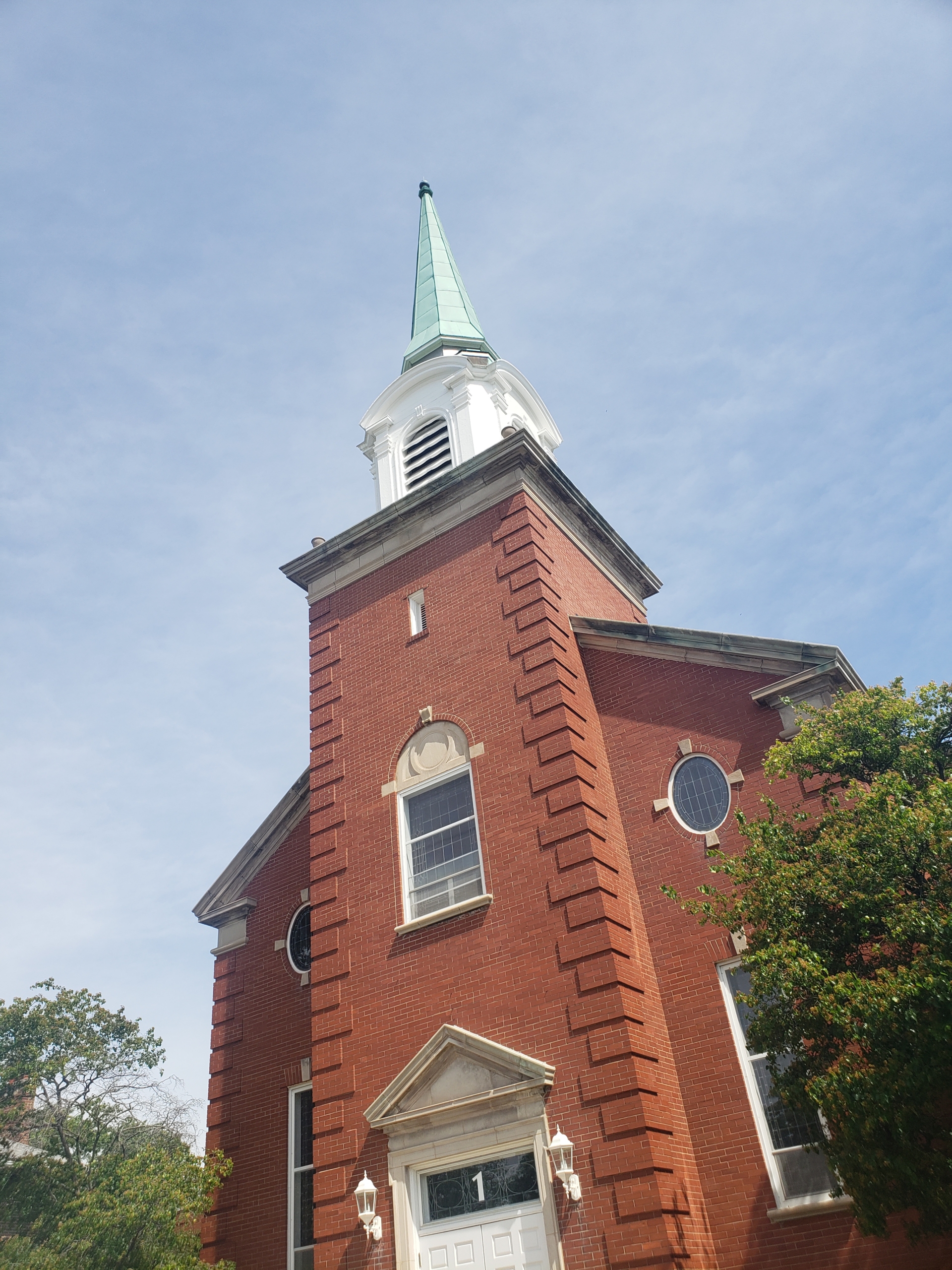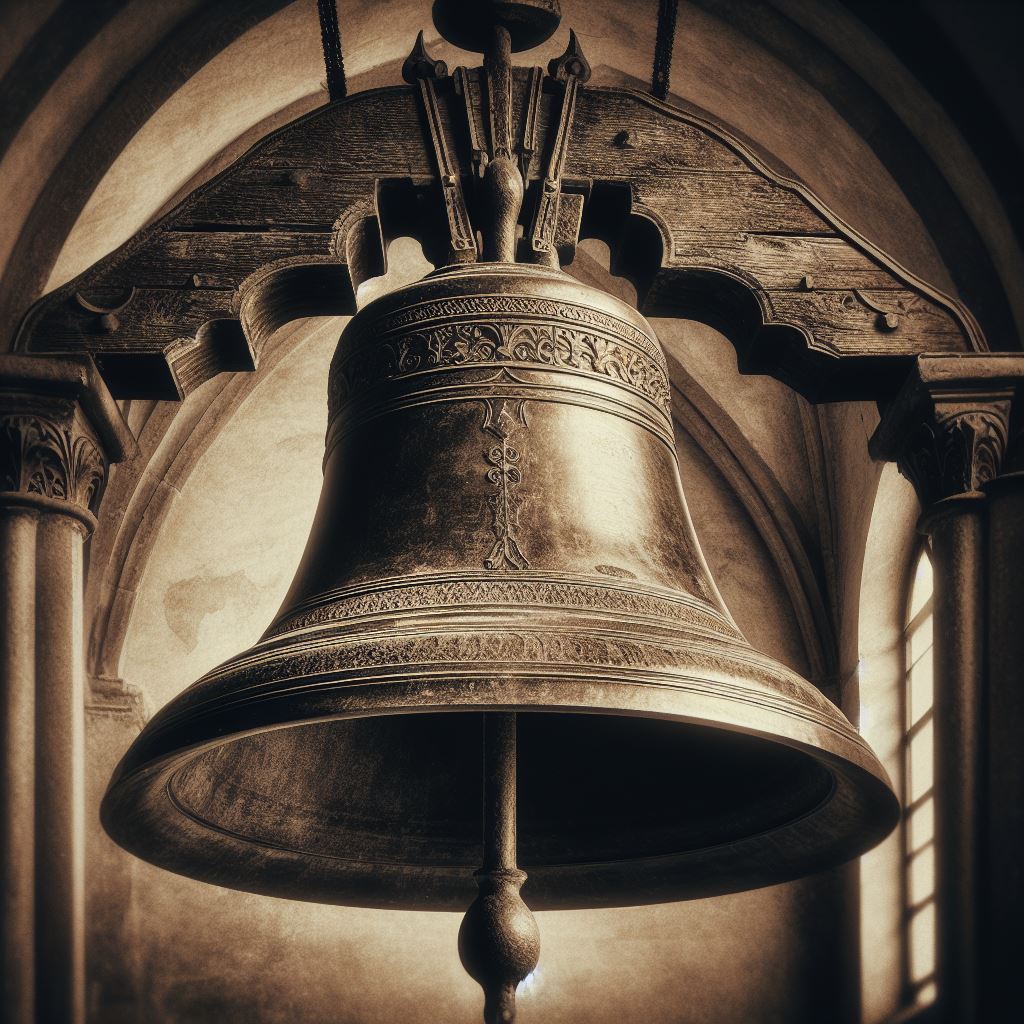Rivers of Thought
Life, Leadership, Business & Technology
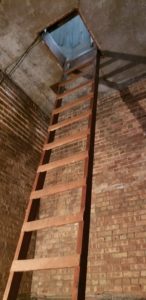 “Don’t fall! Don’t look down! Don’t fall! Don’t look down!” Those messages kept playing over and over in my head! Here I was, 20 feet up, clinging to a wooden ladder that wobbled and shuddered with every step I climbed. The pounding in my chest was part fear, part adrenaline, and part excitement. I was about to lay my eyes (and my hands) on THE bell…my great-great-grandfather’s bell…not quite Indiana Jones and the Holy Grail, but pretty damn cool!
“Don’t fall! Don’t look down! Don’t fall! Don’t look down!” Those messages kept playing over and over in my head! Here I was, 20 feet up, clinging to a wooden ladder that wobbled and shuddered with every step I climbed. The pounding in my chest was part fear, part adrenaline, and part excitement. I was about to lay my eyes (and my hands) on THE bell…my great-great-grandfather’s bell…not quite Indiana Jones and the Holy Grail, but pretty damn cool!
A couple of months ago, I told you the story of my search for the bell my great-great-grandfather procured in 1867 (Pulling on Threads). You know…the story involving five churches, two foundries, and two bells cast twenty years apart over 100 years ago? Well, here’s “the rest of the story!”
I could not let it go. There had to be more. There had to be proof that the Lansing, Illinois, bell was the original. I continued to pull on that thread.
Since the picture of the bell clearly showed it was Cast by A. Fulton. I began to research A. Fulton of Pittsburgh. Andrew Fulton. The foundry did indeed cast church bells in the 1860s. Andrew Fulton, Jr. joined his father in making bells. Junior grew up to be the mayor of Pittsburgh. Now, that is an interesting connection. The foundry went through several name changes as partners joined or left.
My Google searches were not turning up business records that may have been saved. However, the search did reveal that the American Bell Association was having its annual convention this year in…Pittsburgh. One of the educational tracks…Fulton Bells! I reached out to the general email address for the convention and asked if they could put me in touch with the person running the session.
I soon heard back, and they confirmed that Fulton did indeed go through many name changes during its years in business. Since no date was cast into the bell, verifying when it was cast was hard. He did mention the bell “was probably made no later than 1865.” Hmmm, curious. When I told him the story of the fire in 1945 (see Pulling on Threads), he was surprised the bell had survived such a fire. The fall from the steeple would be enough to crack the bell. If the fall didn’t crack it, the intense heat would undoubtedly melt it. Hmmm, curious. He asked if I knew the diameter of the bell. I did not. He explained the approximate weight of the bell can be calculated from the diameter.
I continued to pull on threads.
My research uncovered a book that references Fulton Bells. Large Bells of America: History of Church Bells, Fire Bells, School Bells, Dinner Bells and Their Foundries by Neil Goeppinger. Of course, I ordered a copy!
While I waited, somewhat impatiently, I might add, for the book to arrive. I emailed the First Church (PCA), formerly The First Reformed Church of Lansing. Perhaps they had information about the bell. That started a chain of emails with the church administrative assistant… well, two church administrative assistants both named Sheila. The Sheilas were gracious enough to send me copies of their church rolls from 1861, where some Ton ancestors appeared. They also put me in touch with a local historian who had written about the bell and climbed the belfry to see it.
The book arrived…finally. Of course, I first examined the index and turned to the pages about the Fulton Bells. I was excited to read that they did indeed cast some undated bells with the inscription “Cast by A. Fulton” on the bell. This was confirmation I was on the right track!
I wanted to reach out to the author, but the book had no contact information for him. Google was not much help either. Since the author was a former American Bell Association president, I reached out to my new friends at the Association. Could they put me in touch with Mr. Goeppinger?
Within a few days, I had a voicemail message from him!
I told him the story of the bell, its relationship with my great-great-grandfather, the confusion over the foundry, and the fire. “I’m surprised it survived. Most bells don’t.” He quickly dug through his records and found the information he had on Fulton. “The bell you have was probably cast in 1863 or before,” he said. I explained my GG Grandpa bought it in 1867 or 1868. He said it was possible, but I could tell he had doubts by the drawn-out way he said it. Hmmm, curious. I promised to be back in touch as I learn more.
I reached back out to the Sheilas. “Would it be possible for me to see the bell? Could I climb up in the tower and see it with my own eyes? I would love to measure it.” The response was quick…of course!
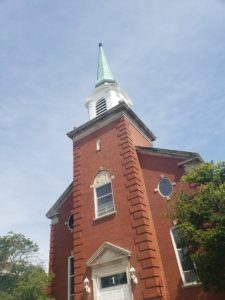 A couple of weeks later, my wife Carmen and I arrived at the church! After introducing ourselves, we were introduced to Mark, the church’s Administrator. He led the way down the hall, through the sanctuary, up the stairs to the balcony, and up a second set of stairs to the control room. The room overlooked the sanctuary and was filled with miscellaneous electronic gear. On one wall was a black metal ladder leading up to a small square hole in the ceiling.
A couple of weeks later, my wife Carmen and I arrived at the church! After introducing ourselves, we were introduced to Mark, the church’s Administrator. He led the way down the hall, through the sanctuary, up the stairs to the balcony, and up a second set of stairs to the control room. The room overlooked the sanctuary and was filled with miscellaneous electronic gear. On one wall was a black metal ladder leading up to a small square hole in the ceiling.
I followed Mark up the ladder and into the attic of the church. We were in a room approximately 20 feet square. One side of the room was open to the attic itself where a long row of rafters formed the roof of the building. The room we were standing in was empty except for a rope that came down from the ceiling and disappeared into the floor. “That’s the rope we use to ring the bell,” Mark explained, “it hangs into the control room.” Doh! In my excitement to climb the ladder in the control room, I had not even noticed.
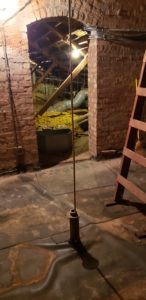 On one side of the room was a tall wooden ladder. The rails were 2x4s, perhaps 25 feet in length. The rungs were 1x4s. As Mark climbed, he stated, “This is a one-person-at-a-time ladder. Wait until I get to the top, and be careful. It wobbles quite a bit.” Mark soon disappeared into a hole in the ceiling. As I began to climb, I realized Mark was right…it did wobble quite a bit, more like shake and shimmy. I was hoping it would hold my weight!
On one side of the room was a tall wooden ladder. The rails were 2x4s, perhaps 25 feet in length. The rungs were 1x4s. As Mark climbed, he stated, “This is a one-person-at-a-time ladder. Wait until I get to the top, and be careful. It wobbles quite a bit.” Mark soon disappeared into a hole in the ceiling. As I began to climb, I realized Mark was right…it did wobble quite a bit, more like shake and shimmy. I was hoping it would hold my weight!
“Don’t look down! Don’t fall!”
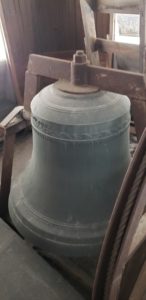 Minutes later, I went through the hole in the ceiling and entered the belfry. Here was THE BELL! I was touching the bell my great-great-grandfather purchased with money he helped to raise. The bell he transported from Chicago by ox cart. The bell that called him and my great-great-grandmother to worship.
Minutes later, I went through the hole in the ceiling and entered the belfry. Here was THE BELL! I was touching the bell my great-great-grandfather purchased with money he helped to raise. The bell he transported from Chicago by ox cart. The bell that called him and my great-great-grandmother to worship.
Aside from the bell, there was barely room for Mark and me. I took several pictures, including one showing the bell was cast in Pittsburgh, not Troy, New York. Mark was kind enough to take a picture of me crouching beside the bell. Before I knew it, it was time to descend out of the belfry.
“Don’t look down! Don’t fall!”
I waited in the attic for Mark to descend the ladder and then descended the next ladder back to the control room. Sure enough, the rope was hanging from a hole in the ceiling, knotted in several places to enable the ringer to keep a solid grip. Carmen and Sheila stood in the sanctuary, looking up at us. Carmen asked if I had wrung the bell. I wasn’t sure it would be allowed, but Sheila encouraged Mark to let me pull on the rope. “Amazing,” I thought as I rang the bell my great-great-grandfather purchased with money he helped to raise! The bell he transported from Chicago by ox cart! The bell that called him and my great-great-grandmother to worship!
But was it?
A few days after our trip, I received an email from Mark. Later in the day of our visit, he talked with one of the church janitors, Dale, and told him the story of our visit. Dale said, no, that is not the original bell. The original bell was destroyed in the fire of 1945. In fact, he has the clapper from the original bell hanging in his garage.
POP! My bubble of euphoria just burst! I was devastated. But I told Mark it was still very cool to climb the bell tower, see the bell, and ring a 150-year-old bell! I asked him to pass my phone number along to Dale. I would love to talk to him about the bell.
A few days later, Dale called.
His grandfather was a member of the First Reformed Church of Lansing. He served as the chairman of the Building and Grounds Committee during the time of the fire. He was one of the first on the scene and watched his dear church become engulfed in flames and burn to the ground.
As the steeple burned, the bell slammed to the ground, making an incredible sound. The steeple toppled into the street.
A few days later, Dale’s grandfather was sifting through the rubble. The bell had broken into three pieces. He found the clapper bent, partially melted, and buried in ash. He took it home and hung it in his barn. When his grandfather passed away, his father and uncle were sorting through his belongings. His uncle told his father to take the clapper because he still attended the church. Later, Dale’s father gave him the clapper, and he hung it in his garage.
If his grandfather ever told him where the bell that hangs in the church today came from, he does not remember. Probably some other church in the area.
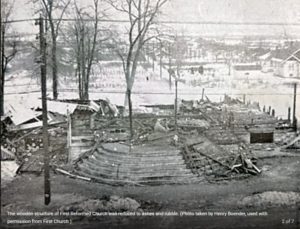
Photo: The Lansing Journal
So, there you have it…the rest of the story! It has been an interesting journey. I learned a lot about bells and their history, made some new friends, and uncovered a bit of history…just not the story I wanted to uncover!
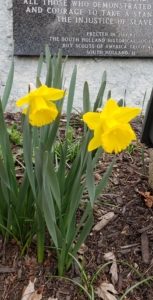 March 21st – traditionally recognized as the first day of spring. This year, I once again found myself on Chicago’s south side, visiting the location of my ancestor’s farm, now Chicago’s Finest Marina. Fitting for the start of a season that symbolizes rebirth. I was there to celebrate the gift of additional signage from the Kingdom of the Netherlands. Birgitta Tazelaar, Ambassador of the Kingdom of the Netherlands to the United States of America, delivered the keynote address. I was honored to represent Jan and Aagje and the Ton descendants and welcome the Ambassador.
March 21st – traditionally recognized as the first day of spring. This year, I once again found myself on Chicago’s south side, visiting the location of my ancestor’s farm, now Chicago’s Finest Marina. Fitting for the start of a season that symbolizes rebirth. I was there to celebrate the gift of additional signage from the Kingdom of the Netherlands. Birgitta Tazelaar, Ambassador of the Kingdom of the Netherlands to the United States of America, delivered the keynote address. I was honored to represent Jan and Aagje and the Ton descendants and welcome the Ambassador.
“Mevrouw Ambassadeur, namens Jan en Aagje Ton, welkom!”
The new signage tells the story of Jan and Aagje Ton and other Dutch settlers in the area in the second half of the 19th century and their participation in the Underground Railroad. The left panel was written in English, and the right panel was in Dutch. Jan and Aagje would be honored. Though they left their homeland and loved their new country, they never forgot their roots. To be remembered by the land of their birth 125 years after their passing, in the language they loved…the language of their worship…would have been inconceivable to them.
After unveiling the new sign, Ambassador Tazelaar shared these words: 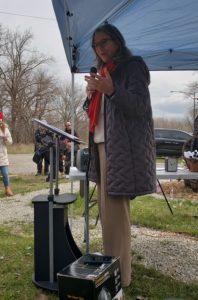
“It’s a real privilege to be here at what my ancestors indeed called the “lage prairie”* or the “hoge prairie,”* to learn about the freedom seekers, the underground railroad, and their journey on the road from Chicago to Detroit and onto Canada to freedom. And listening to the stories of Dutch families that defied the Fugitive Slave Act to help them on their way makes it more special.
I’m honored to have unveiled this interpretive panel together with Mister Harrington that tells the stories of Dutch settlers and their work on the Underground Railroad, and I look forward to seeing it permanently installed.
After this event, I will be heading to DuSable Black History Museum for the opening of an exhibition called Slavery – Ten True Stories of Dutch Colonial Slavery. And this is done in part with the Rijks Museum of Amsterdam. The exhibition is part of the Netherlands’ commitment to acknowledging our past.
In December 22, Prime Minister Rutte, our current prime minister, formally apologized for the nation’s ugly, painful, and downright shameful role in slavery. Also, King William Alexander reiterated that apology a few months later and recognized that the legacy of slavery remains with us today. The King also announced that he had commissioned an independent study to shed more light on the role that the royal house played in our colonial past and [the] history of slavery.
Being here at Chicago’s Finest Marina, once the farm of Dutch settlers Jan and Aagje Ton, is an encouraging reminder that even amidst that painful history, there are examples of inspiring moral conviction, the resilience of human spirit, and the humanity shared by the people of our two nations. I’m talking about the courageous freedom seekers who escaped the bonds of slavery, heading north and encountering Dutch immigrant families living on the Little Calumet River.
The Tons and the Kuypers recognized the freedom seekers first and foremost as people who needed help. They knew that providing a place to stay or ride across the river, the bridge, was the right thing to do despite the risk. They were breaking the law, as Professor Schoon also mentioned. But they held the higher moral high ground to do so. And I’m proud of the Tons and the Kuypers. I’m proud that their actions paved the way for The Netherlands to be involved in the Little Calumet River Underground Railroad Project today.
It’s incredible to see a diverse group of individuals and organizations, churches, schools, and community groups that came together to rediscover this inspiring story and share it with the world. In particular, I would like to thank the Gaines family for hosting…for hosting us and stewarding this land, as well as Larry McClellan, Tom Shepherd, and Rodney Harrington, and everyone else that is involved in the Little Calumet River Underground Railroad Project.
Standing here, it’s clear that the story of the freedom seekers, the Dutch settlers on the Little Calumet, and the Underground Railroad has many forms. First and foremost, it’s a big story, a story of bravery and danger, a drama that touches many of the overarching themes of American history, themes like slavery, immigration, and civil disobedience.
At the same time, it’s a small story, a deeply normal story, a story of regular people helping other people purely because it was the right thing to do.
And finally, it’s a story about our shared values, values that bind The Netherlands and the United States today, our cultural heritage, our commitment to human rights, and above all, our deep dedication to freedom.
Thank you very much.”
*Low Prairie and High Prairie

Later, as I walked about the grounds and contemplated her words, much of what she said stood out.
“ the nation’s ugly, painful, and downright shameful role in slavery”
“ examples of inspiring moral conviction, the resilience of human spirit, and the humanity shared by the people”
“courageous freedom seekers”
“incredible to see a diverse group of individuals and organizations, churches, schools, and community groups that came together to rediscover this inspiring story”
“overarching themes of American history, themes like slavery, immigration, and civil disobedience.”
Because I had been reading about the history of the Doctrine of Discovery and its continuing impact on our beloved country and its people, words kept popping into my head. Words like reconstruction…restitution…reparations. It seems we need reconciliation before any of that can occur. Reconciliation of our past and our love of our country. Reconciliation with each other as people.
It struck me. I have felt all of what the Ambassador said. I AM proud to be an American, yet, there are parts of our history that are indeed shameful. I am honored that Jan and Aagje are remembered for their abolitionist activities, yet embarrassed that we remember them instead of the brave freedom seekers and their descendants. That is what these grounds mean to me. That is what the Jan and Aagje Ton Memorial Garden means to me. They are symbols of reconciliation. Reconciliation of my own feelings with our past. Reconciliation of the communities of Roseland, Riverdale, and South Holland. Reconciliation of the people who come together to remember the past and commit to moving forward…together.
I think of Nadine Harris Clark, her sister, and others who volunteer countless hours to keep up the Memorial Garden and the grounds around the historical site at the Marina. If someone you barely know or see perhaps once a year can be described as a friend, I would describe Nadine as even more than that…she is family. During this visit, I had the chance to meet her husband, William. We had a great conversation about the event, the place, and the history. We quickly became friends and, dare I say, family as well.
I think of Ron Gaines and his family, the owners of Chicago’s Finest Marina, which stands on what once was Jan and Aagje’s farm. Before that, it was home to the Ojibwe, Odawa, Potawatomi, Miami, Ho-Chunk, Menominee, Sac, and Fox Nations. Ron is a retired Chicago police officer, and his two sons and daughter still serve. (Hence, Chicago’s Finest Marina!)
I think of Tom Shepherd, Larry McClellan, and countless others who have toiled to bring this story to the surface and help us all remember it. Their work has brought communities together and created a spark of reconciliation.
That is what remembering Jan and Aagje means to me.
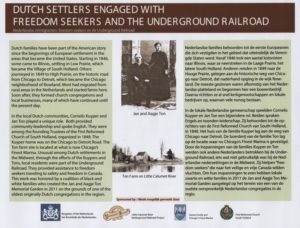
************************************************************
For those of you who may be new to my journey of the last several years or those who want to refresh their memories. Here is a brief recap and links to the journey’s posts.
Almost four years ago, I told you about my journey. A journey of discovery. You may recall I learned of my great-great-grandparents’ involvement in the Underground Railroad. Their farm on Chicago’s southside served as a stop for freedom seekers on their way to Indiana, then Michigan, and ultimately, Canada. I learned of this on Juneteenth, 2020.
In 2020, Carmen and I watched a webinar led by Dr. Larry McClellan, a historian who has dedicated this part of his career to uncovering the forgotten history of the freedom seekers’ journeys across Illinois and Indiana. What followed was the devouring of dozens of books, multiple trips to Chicago, and untold emails and texts as I learned more of the story.
One of my most treasured moments of this journey occurred in 2021. On our way to scatter my father’s ashes in Wisconsin, we stopped at the Jan and Aagje Ton Memorial Garden we had learned about in the webinar. It was there we met Nadine Harris Clark, the aunt of LeRone Branch. “We” being me, my wife Carmen, and my son Brad.
During our visit in 2021, we learned that the Memorial would be re-dedicated that fall to commemorate the Tenth Anniversary of its installation…on the same day as my 45th high school reunion…in Evansville, Indiana, three hours further south from the Memorial from where I live in Indianapolis. I was torn. You can read about the serendipitous events that enabled us to attend the rededication AND meet LeRone Branch, the Eagle Scout who built the Memorial in 2011 here.
My journey continued in 2022. Signage was to be dedicated on the site of their homestead, now the Chicago’s Finest Marina. I made the trip to help represent the Ton Family at the ceremony. The Netherlands Consul General Bart Twaalfhoven from the Chicago Embassy was there to commemorate the occasion. It was an honor to meet him. It was an honor to be standing on Hallowed Ground.
Our next stop on the journey was in 2023. Carmen, my son Brad, and my grandson Jordan took a trip to Chicago – three generations of Tons. My primary reason for the trip was participating in one of Larry McClellan’s tours about the Underground Railroad. To surprise my grandson, we included a stop at the United Center to visit the Michael Jordan statue. Oh…did I mention my grandson’s name is Jordan…named after the legendary Chicago Bull? Alas, I did not write about the journey. However, the highlight for me was getting back on the bus after one of the stops and Jordan showing me an internet post he had found on his phone showing Jan and Aagje’s farmhouse…he WAS paying attention.
On the most recent trip, I included an extra stop to visit a historic bell on the grounds of the Thorn Creek Reformed Church in South Holland. That stop revealed an entirely new thread to pull on!
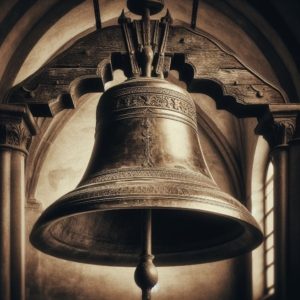 I couldn’t tell you my earliest memory of hearing church bells. I can only tell you, as the son of a preacher, my guess is I’ve heard church bells most of my life. Growing up in a small town in the Midwest, I remember hearing the bells tolling every hour on the hour…and at noon, they would play a short song, er uh, hymn. There is something about playing outside on a warm summer day with bright blue skies and hearing the bells reverberate through town. It’s kind of like baseball and apple pie.
I couldn’t tell you my earliest memory of hearing church bells. I can only tell you, as the son of a preacher, my guess is I’ve heard church bells most of my life. Growing up in a small town in the Midwest, I remember hearing the bells tolling every hour on the hour…and at noon, they would play a short song, er uh, hymn. There is something about playing outside on a warm summer day with bright blue skies and hearing the bells reverberate through town. It’s kind of like baseball and apple pie.
I do remember our annual visits to the Green Lake Conference Center (or just Green Lake as we called it) and the carillon chiming high atop Judson Tower. The peals could be heard across the grounds and from the lake. Trekking the 121 steps to the top of Judson Tower rewarded you with an experience you could feel from the top of your head to the tips of your toes!
When I was in high school, I joined the handbell choir at church. We made some beautiful music if I do say so myself! Our choir became fairly well known in town and we were able to play some high-profile concerts. We made some incredible music…even this old rock and roller has to admit that!
Today, our house reverberates with chimes (bells) from a cuckoo clock, outdoor windchimes, and my grandmother clock (my mother’s clock and she insisted it was NOT a grandfather clock, it was a grandMOTHER clock!
All of this is to tell you why I had to make an extra stop on my most recent trip to Chicago. I had to see the bell. What bell, you ask? Well, let me tell you the story…
Great-Great-Grandfather and The Bell
In 1849, a group of families immigrated from The Netherlands to the south side of Chicago and settled in what is now called Roseland. They called the area High Prairie. These Dutch were devoted members of the Dutch Reformed Church. Soon after their arrival, they founded the First Reformed Church of Roseland.
By 1867, the church had outgrown the house they had been using for services and decided to build their first church building. The frame church at 107th and Michigan Avenue included a wonderful steeple and belfry. Wonderful…but empty.
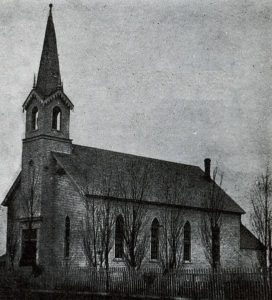
First Reformed Church of Roseland
According to my great-great-aunt Neeltje (Ton) Jansen, daughter of Jan and Aagje Ton (my paternal great-great-grandparents), this bothered her father to no end. As one of the church’s founders, he took it upon himself to raise money for the bell. He donated the first $100 and, in a short time, had the $300 they would need to buy a bell (that’s about $6,500 in today’s dollars). As he collected the money, he gave the money to Aagje, who hid it in an old beaded bag and put it in a drawer for safekeeping.
One night, long after dark, two men knocked on the door asking for directions. When Jan stepped out to point the way, they hit him in the forehead with a slingshot. The two attackers held him down and demanded the money. Bleeding profusely from the wound, he led them to a closet and gave them the money from his trousers. The men knew he had been raising money for the bell and knew there had to be more. They beat him, threw him in the closet, and locked the door. They then proceed to ransack the house. Pour Aagje was confined to her bed, just having given birth two or three days prior, she hid the other children with her and waited. Finally, the men gave up and left. Though they rummaged through the drawer containing the money, they failed to realize the beaded bag contained what they sought.
The very next day, Jan sent the money to Troy, New York, to pay for the newly founded bell.
Our story does not end there.
The Bell Arrives
About a month later, Jan received notice that the bell had arrived in Chicago, he tied his team of oxen to the wagon and rode the 20 miles to the small town along the lake. Possibly to the same port he and his family had arrived at 18 years before.
Three days later, Aagje had not heard from Jan. Distraught, she asked two neighbors to search for him. They found his wagon bogged down in the mud and the bell lying half-buried in the muck near The Eleven Mile House Tavern (92nd and State Street). When they found Jan, he recounted the ordeal of getting stuck in the mud with the heavy bell. His efforts to free the wagon tipped the bell into the mire. Since he was alone, he could not lift the bell back onto the wagon, so he just decided to wait, thinking, “Someone will come looking sooner or later.”
The men rescued the bell and a week later, it was hung in the belfry and called its first worshippers to services.
Visit to The Bell
That was my extra stop…to see the bell. Although a distant cousin had sent me pictures of the bell, I had to see it myself! The bell rang in the belfry the First Reformed Church of Roseland at 107th and Michigan Road until the church built a much larger facility in 1887 just south of the intersections at 107th Street. The bell was later moved to the First Reformed Church of Lansing (Illinois). Today it is on display at Thorn Creek Reformed Church in South Holland, IL…or is it?
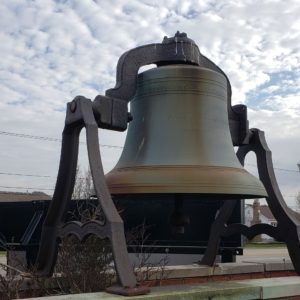
The Bell?
It is now a few weeks after my visit. I knew I wanted to tell the story of the bell. As I wrote, I kept referring back to the pictures I had taken that day, the book about Roseland Down an Indian Trail in 1849 by Marie K. Rowlands, and the story my great-great-aunt had written in 1932. Something was off, but I wasn’t sure what. Then I saw it. The bell at Thorn Creek certainly was forged in Troy, New York as Ms. Rowlands wrote in her book…but the date…the date forged in the bell was 1887…- 1887, not 1867.
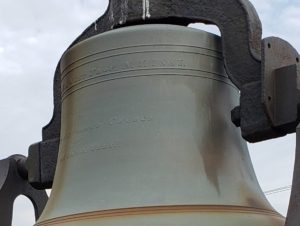
The Date?
So, I began pulling on threads. Those threads led me to research five churches, two foundries, and the history of the Dutch Reformed Church and its various successions and splits.
The First Reformed Church of Roseland did, in fact, build a new larger building in 1887. It seems they must have ordered a new bell for the new facility. The original bell, no longer needed, made its way to the First Reformed Church of Lansing (Illinois). A brother-in-law of Jan’s helped to found the Lansing church. Perhaps that is why the bell was gifted to them?
The Fire
The Lansing church built its first building in 1897. That building burned to the ground in a huge fire in 1945. Newspaper articles from the time describe the steeple (and the belfry) crashing down into the street. An eyewitness, who was ten at the time of the fire, remembers the sound the bell made as it slammed into the roadway.

THE Bell
Photo: Daniel Bovino
The congregation raised money and built a new building on the same spot. Two area historians believe the bell hanging in the belfry of the new building (completed in 1947) is the “Ton Bell.” If it is, it creates another question. Cast into the bell is the name of the bell founder, “A. Fulton.” I cannot find any reference to a bellmaker in Troy, New York, by that name. I can, however, find a renowned bellmaker who had a foundry in Pittsburgh, PA, in the 1800’s. Could the author of the “Indian Trail” book have made a mistake when she wrote, “Ton dispatched the money to Troy, New York with an order for the bell”? That now seems likely.
As for the 1887 bell that is on display in front of the Thorn Creek Reformed Church, how did that bell find its way there? It is clearly cast for the First Reformed Church of Roseland. The answer is less of a mystery than I thought. You see, the Thorn Creek church IS the Roseland church. The church moved to South Holland in the early 1970s. I assume, since there already was a First Reformed Church of South Holland, they named themselves Thorn Creek.
Sometimes when you pull on threads, you confirm the past, sometimes, you reach a dead-end, other times, you gain new insights that rewrite the story. I will keep pulling on threads…
The First Reformed Church of Roseland, IL
- established 1849,
- Original building built 1867
- “Ton” Bell Purchased circa 1868
- New building built 1887
- Second bell (now at Thorn Creek) cast 1887
- moved to South Holland, IL circa 1971
The First Reformed Church of Lansing, IL, established 1861, today called Lansing First Church PCA
- original building built 1897
- “Ton” bell hung in belfry
- Building destroyed by fire 1945
- New building built 1947
- “Ton” bell hung in new belfry
The First Reformed Church of South Holland, IL
- established 1865
- Reorganized 1886
- Site of the Jan and Aagje Ton Memorial Garden 2013
Thorn Creek Reformed Church, South Holland, IL
- First Reformed Church of Roseland relocated to South Holland circa 1971
- Home of the “second” bell from 1887
Lilydale Progressive M.B. Church, Roseland, IL
- Bought the building built in 1887 from the First Reformed Church of Roseland when they moved to South Holland and became Thorn Creek circa 1971

Insights is the weekly, thought-provoking newsletter from Jeffrey S. Ton.
Every Tuesday – Delivered to your inbox.
A different focus each week:
Leadership Thought – A lesson-learned, an insight shared
Leadership Q&A – A response to a reader’s or a connection’s question
Leadership Spotlight – A highlight of a person or company helping others to grow their leadership
Rivers of Thought – A more personal thought, observation or musing

